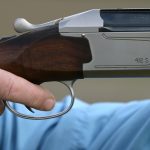The Gun Room: Gun Fit
by Steve Smith
There is a subject that all shotgunners are familiar with, maybe even talk about, and yet very, very few of us ever do anything about, and as you can tell from the title, it’s gun fit. That is, the revolutionary idea that a shotgun should hit where you are looking. Problem is, (a) guns off the rack are pretty much stocked all the same yet are sold to shooters who aren’t; and (b) almost everyone lives with the stock fit the manufacturers figure will work for most people most of the time.
Shotguns are pointed, not aimed, of course. Aiming requires the shooter to look at the target, then line up the weapon’s sight(s), then look back at the target again. It’s that “looking at the sight(s)” part that you can do with a rifle but not a shotgun. You do that, and by the time you’re ready to shoot, the bird has flown off, found a mate, and is halfway done building a nest. No, the bird is the target, and our eye is the sight, so the gun has to match what the eye is seeing: It has to, as I said, hit where you’re looking.
I think one of the reasons that more shooters don’t try to improve the fit of their shotguns is because they either don’t know how, or they figure they’ll screw things up and ruin the stock. Great concerns, for sure. There are fixes that can be done easily, but let’s first look at what “good fit” actually is.
For an upland shotgun, we have to think about the sorts of shots we’ll be getting based on the birds we hunt. Like a lot of wingshooters who are a little obsessive-compulsive, I have a number of shotguns. I have one I use for grouse and woodcock, another I use for quail, another I use for pheasants, and then I have a couple duck guns. And, oddly enough, I don’t want those guns to all fit the same because I shoot them at birds with somewhat different flight patterns when they flush.
All upland birds are going to be shot as they are rising, so a shotgun should be stocked to throw its charge a bit high so you can get your cheek down on the stock, see the bird above the barrel(s), and still center the bird. In effect, then, we are shooting up a bit. For example, my grouse and woodcock gun is stocked to shoot so that the pattern hits 60 percent above the point of “aim” and 40 percent below. Likewise, my pheasant gun is stocked the same way because those three birds’ flight patterns are rising, often very steeply, and high shot-charge placement gives me a little built-in vertical lead. The gun I use for quail, though, shoots at a 55/45 pattern breakdown, that is, it shoots a little flatter because quail, after an initial shallow rise, fly flatter, often closer to eye level.
My ducks guns (an over-under and a pump) are stocked at 50/50 because so often the shots are at dropping-in birds. Or, I’m sitting and don’t or can’t get my face down on the stock as well as I would if I were standing, so I need the guns to shoot a tad lower.
Now, those don’t seem like a lot of differences among them, but you’d be surprised how much different the patterns look when fired the same way.
I mentioned that we too often don’t try to improve our gun fit, instead fitting ourselves to the shotgun and not the other way around. I would compare that with walking around with your stomach sucked in because your pants are too tight in the waist.
Here’s an example, one I have related in this column in the past: A friend of mine, hunting with a new over-under, was missing pheasants because he was shooting over the top. He finally started hitting them when he consciously tried to shoot lower by, in effect, aiming lower. When he told me that, I said if he shaved a little wood off the comb on the stock, the gun would shoot where he wanted it to. He looked at me, looked at the beautiful stock, and just shrugged. No way he’s carving that thing up.
Which leads us into a discussion of how to change your shotgun’s stock so it shoots where you want it to, which is where you’re looking. But to do that, you need to know where the thing’s shooting. So, get a sheet of cardboard of good size by cutting up a box, draw a black circle in the middle of it as a point to shoot at, tack it to a tree so that mark is at your eye level, screw in the Full choke tube (if you have one), walk back 15 or 20 yards, and count off one second in your firing sequence: one-thou-sand-one…start your mount with the first “one,” and pull the trigger when you hit the second “one.” That way, you won’t have time to aim, you’ll have to point. Fire three shots so that you get a good average. Walk up and take a look at the results. By using a tight choke and/or standing close to the target, the shot are not spread all over, making it easier to see where the impact is. If you have a gun you use for a specific bird, try patterning it at the distance you figure is about what your average shot is at that bird.
That impact is going to be in one of five places: too high (that is, more than 55 percent above the spot you shot at, 55/45 being a nice, all-around shot placement if you are using that gun for all your bird hunting), too low, too far left, too far right, or – like Baby Bear’s porridge – just right. Now, what to do if it’s one of those first four.
 If the shot placement is too high, there are two options. The first is to sand down the comb a little at a time, and shoot patterns until it’s hitting where you want, then refinish the stock or have it done. The other is to change the pitch if the shot placement is not overly high. The pitch is the angle at which the butt of the stock is cut off and therefore how it fits in your shoulder pocket. If the shot is too high, place a rubber washer or two so that the top of the recoil pad is pushed out. Do this by running the screw holding the top of the pad through the washers.
If the shot placement is too high, there are two options. The first is to sand down the comb a little at a time, and shoot patterns until it’s hitting where you want, then refinish the stock or have it done. The other is to change the pitch if the shot placement is not overly high. The pitch is the angle at which the butt of the stock is cut off and therefore how it fits in your shoulder pocket. If the shot is too high, place a rubber washer or two so that the top of the recoil pad is pushed out. Do this by running the screw holding the top of the pad through the washers.
By pushing the top of the pad out from the butt, the gun will come into your shoulder at a different angle, that is, pointing down more. You’d be surprised how well this works, and it’s a whole lot easier that sanding and finishing a stock. If this is the answer, get a gunsmith to shape a recoil pad to copy the angle you’ve achieved.
If the gun is shooting too low, there are lace-on or stick-on pads that go over the comb of the stock, in effect raising it and making the pattern hit higher. You can also first try the rubber-washer trick by inserting the screw at the bottom of the recoil pad through one or two of them.
Less common than the need for up or down adjustments, in my experience, are side-to-side adjustments. Simply, if the pattern hits to the left (for a righthander), the stock is too thick and you’ll have to shave a little wood off the left side of the stock where you place your cheek. Do it gradually and shoot as you go until you’re there.
 If the pattern is hitting too far to the right, you need to build up the same spot on the stock. You can do this with a stick-on pad placed on the side of the comb, but not over the top – you want to push your face away from the stock a bit. Add layers until you’ve got it right. In this case, you may be able to find a commercially made pad designed to do that very thing.
If the pattern is hitting too far to the right, you need to build up the same spot on the stock. You can do this with a stick-on pad placed on the side of the comb, but not over the top – you want to push your face away from the stock a bit. Add layers until you’ve got it right. In this case, you may be able to find a commercially made pad designed to do that very thing.
Just because you have the stock the way you want it when you’re 25 doesn’t mean the gun’s going to shoot to the same place when you’re 55. Several decades ago I got pretty chubby, so I went on a diet for several months and lost 48 pounds. I got thinner all over, of course, especially in my face, so, in effect, there wasn’t as much padding between my cheek and the comb of my guns, and I started to shoot low. I added a slip-on pad on one gun and used the rubber washers on another, and things improved. I used the slip-on pad on a gun that for some reason shot both low and to the right. I added a layer of moleskin to the inside of the pad on the left side of the stock, so the pad both raised the stock and thickened it.
As we age, our neck muscles and joints stiffen, and we don’t get our face down on the stock like once we did when we turned the heads of young lasses we passed on the street, so the patterns should be shot and adjustments made. Have you gained weight, lost weight? Have you, following what looks to be a planet-wide movement, grown a beard? If so, it will make your face fuller everywhere you place it on your gun’s stock, and your fit will change.
One more thing, and it may seem little to you, but we have a tendency to shoot patterns matter-of-factly and get excited when we’re shooting birds. When I shoot patterns, I do it with my mouth closed, but I have my mouth slightly open when I’m shooting birds, sort of an Oh my gosh they’re getting away type of thing. If you shoot mouth closed or ajar, it changes the fit slightly. So keep track of how you shoot game, and do the same when shooting patterns.
Don’t figure one fitting will do it for your lifetime of shooting. But it’s sure nice to have a gun that fits – and hits – where you’re looking.



